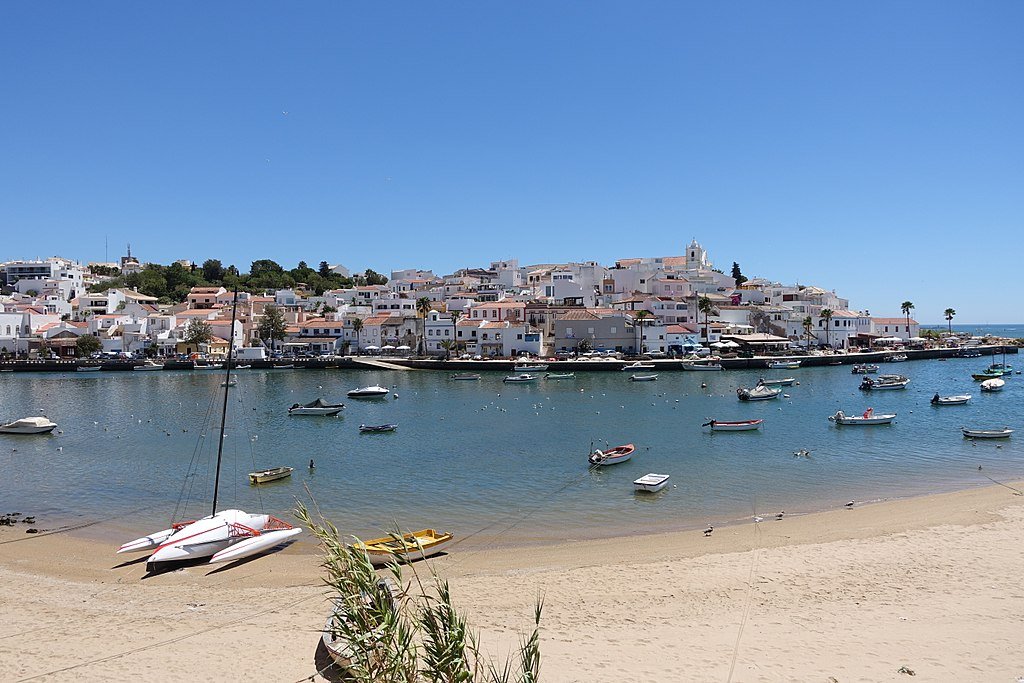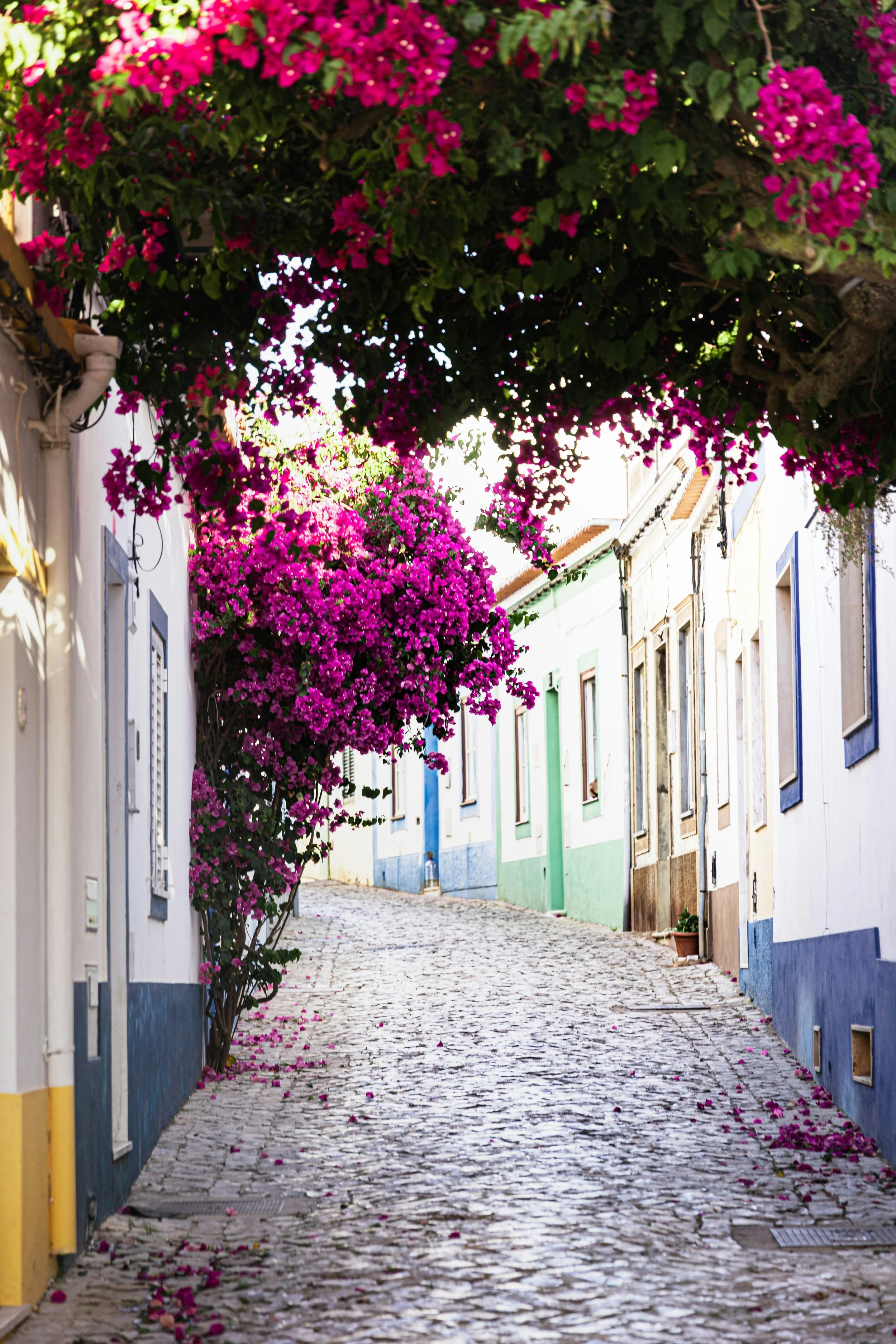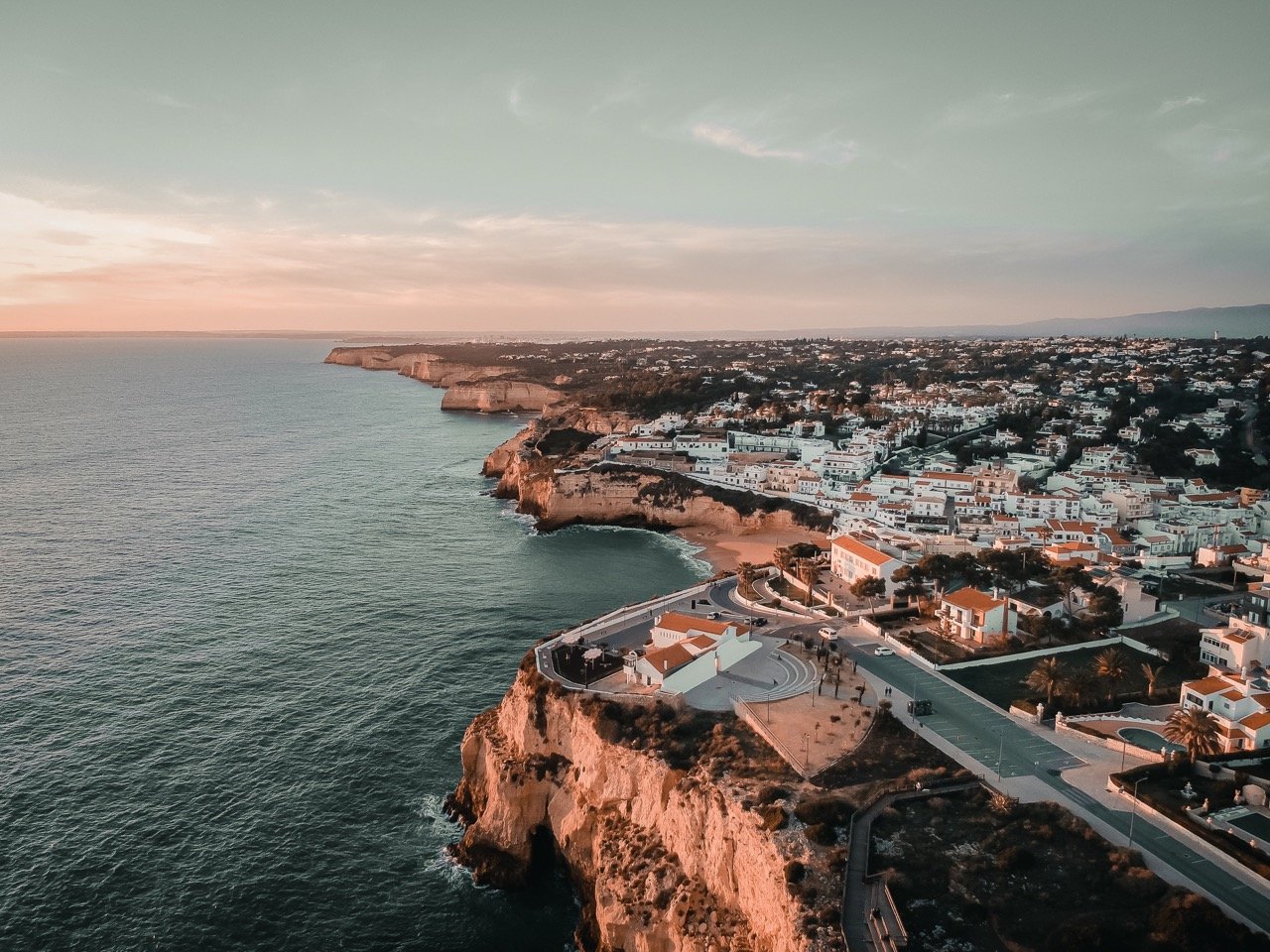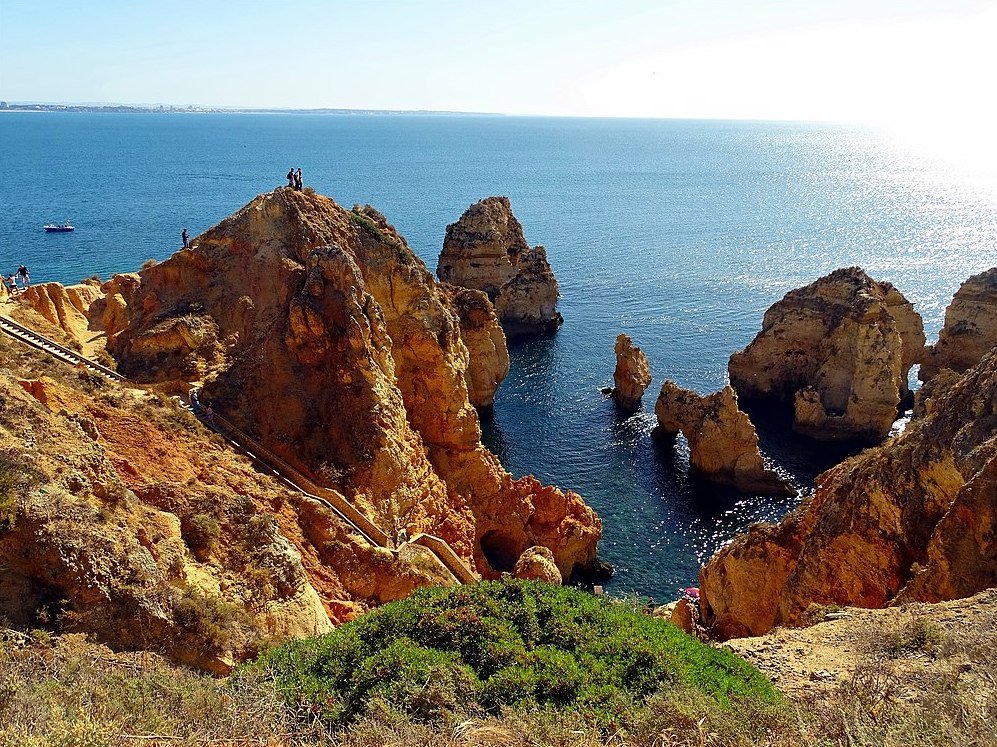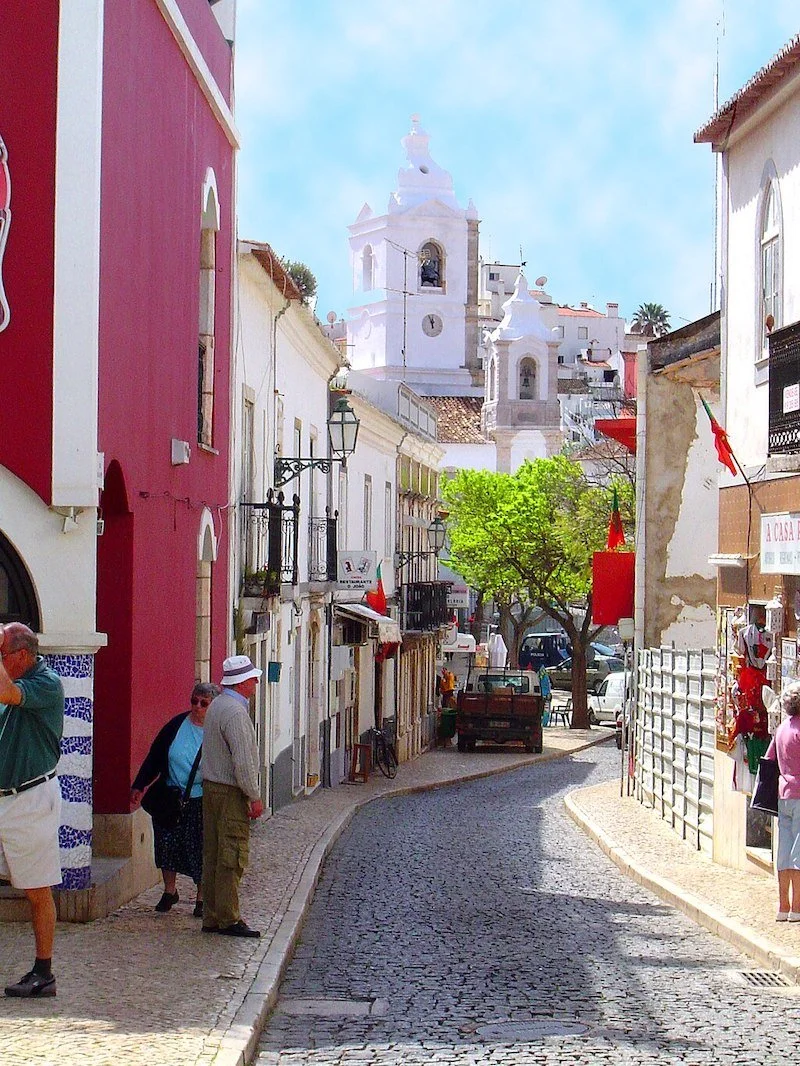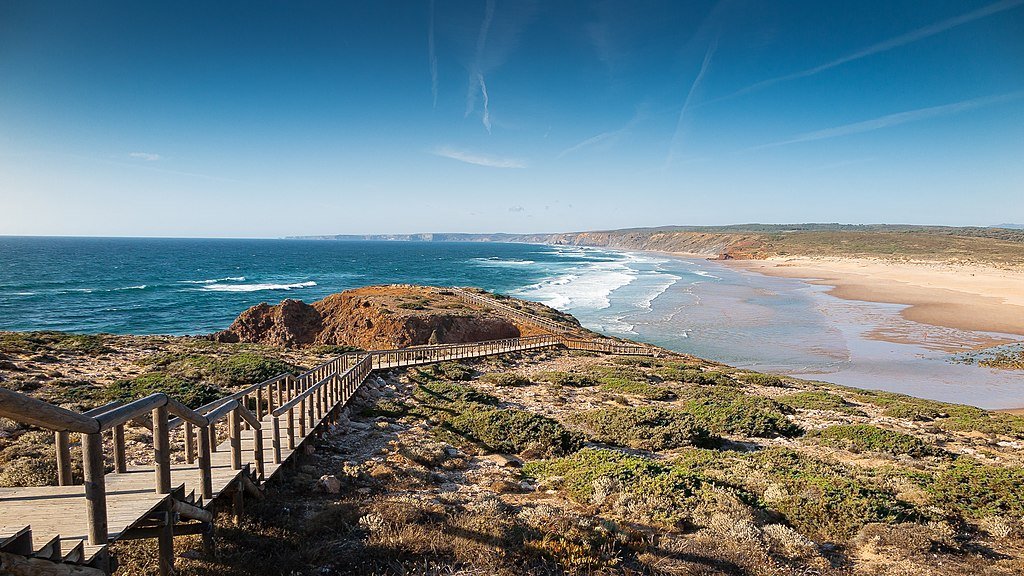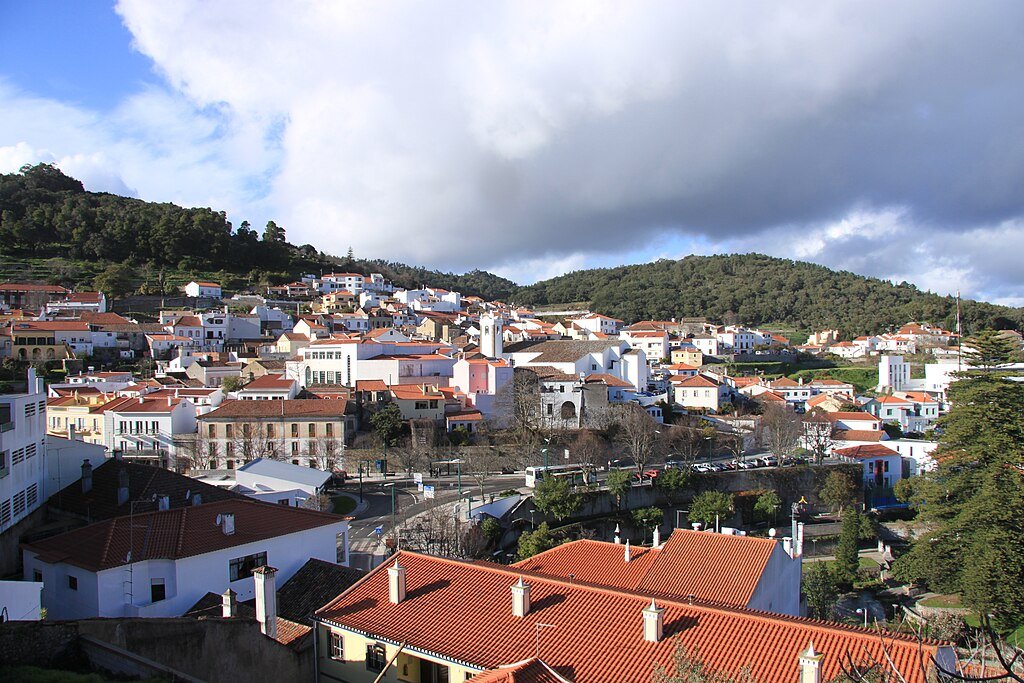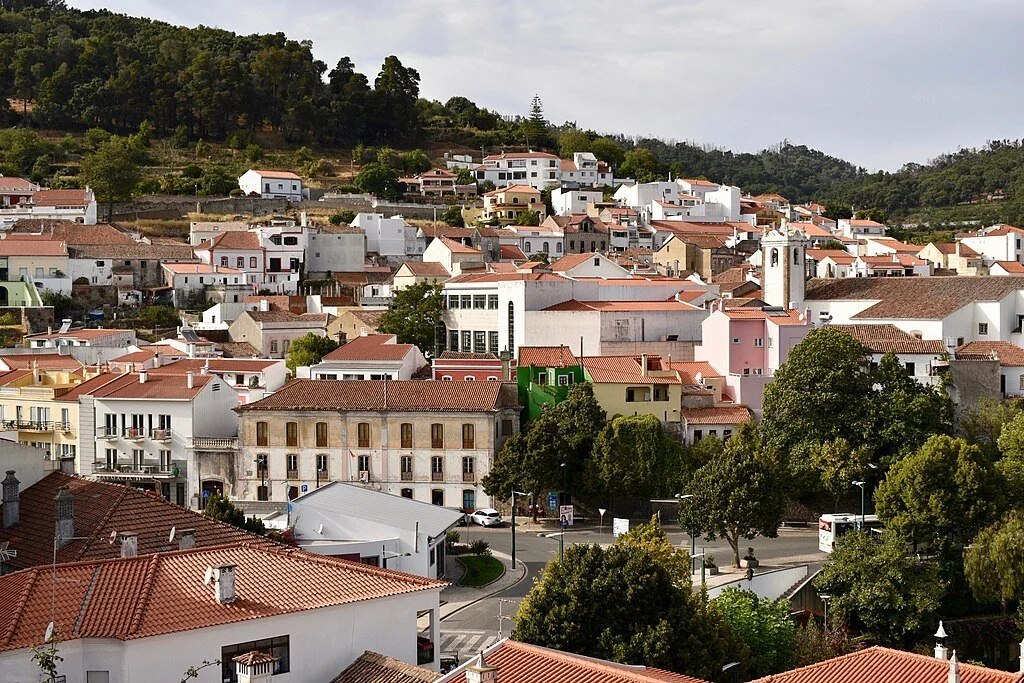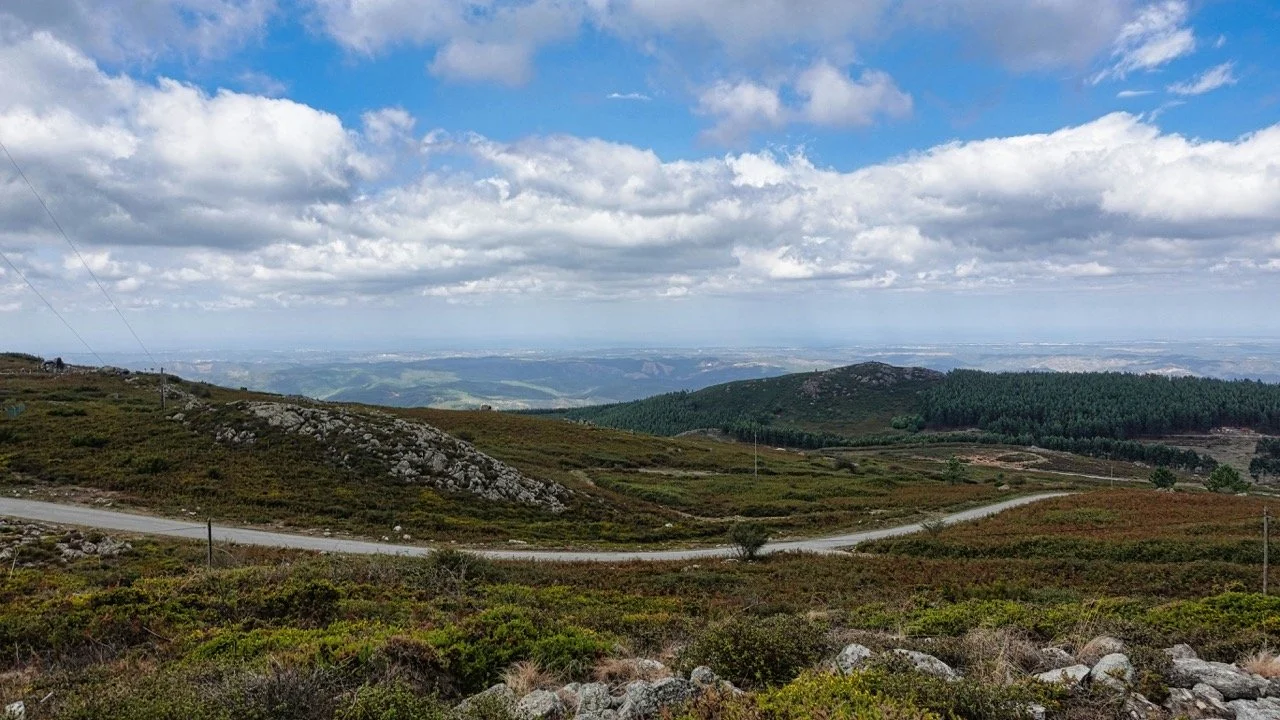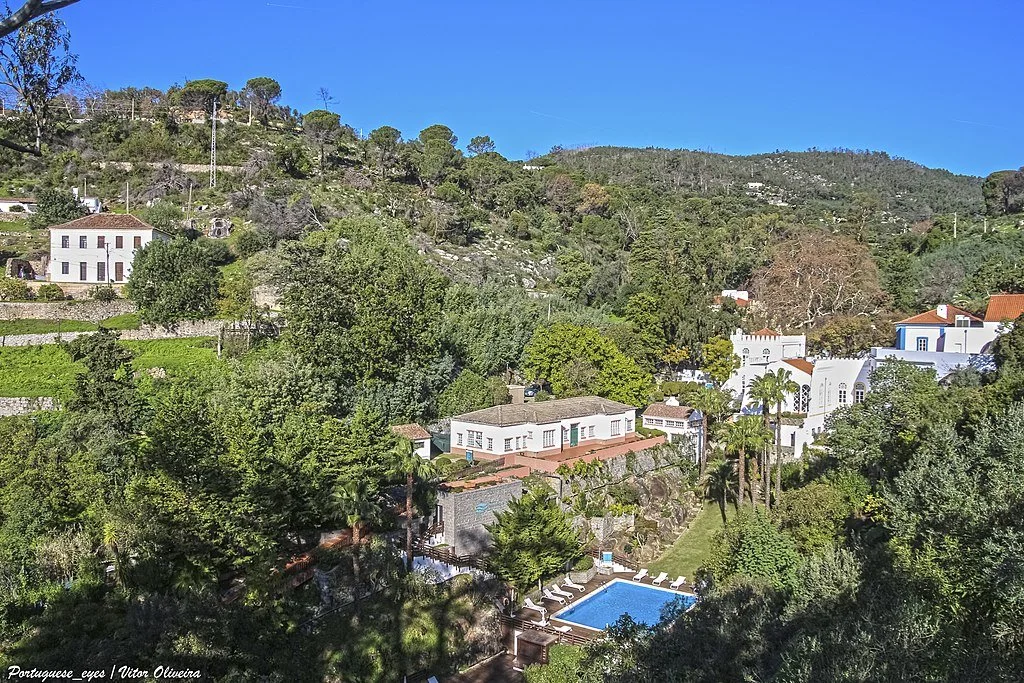One Week in the Algarve - A Local’s Itinerary
Affiliate disclosure: some of the links in this article are affiliate links. If you book using one of them, we’ll earn a small commission. All of our info is free to read and free of ads, so we appreciate it!
When people think of the Algarve, it's typically sunny weather, golden sandy beaches, and gorgeous sea views that come to mind. And don’t get me wrong, we have those things in abundance. But there’s so much more to the region than just our beaches and it’s a real shame that people don’t get to discover it.
Away from the coast, visitors are always surprised by the charming villages in the countryside, the magnificent mountains in the north, and the really interesting history and culture, dating back to prehistoric times, found everywhere.
Although you can visit the whole of the Algarve in a 7-day trip, you’d only get to see the biggest towns and cities and the most over-crowded beaches. You’d leave out the most authentic places, which I think are the best.
For that reason, I’ve prepared this 7-day itinerary to focus only on the Western Algarve, providing you with a mix of must-visit towns, great beaches, lovely countryside, and hidden gems. Moreover, a visit to the Algarve should be about relaxing, so this plan gives you plenty of time to kick back on the beach, savor a glass of wine, go for a long walk, or just do nothing at all. As it should be!
While you could do the itinerary using public transport, you’d lose a lot of time and it wouldn’t be ideal. To make this and any other Algarve itinerary work as well as possible, I really recommend that you rent a car.
Table of Contents
Algarve planning cheatsheet
 Plan your itinerary with expert advice
Plan your itinerary with expert advice
- Book a Portugal travel consultation with a local expert
 My favorite hotels in the Algarve
My favorite hotels in the Algarve
- Bela Vista Hotel & Spa - pure beachfront luxury in Portimão. $300+/night
- Tivoli Carvoeiro - 5-star with stunning sea views atop Carvoeiro's cliffs. $300/night
- São Paulo Boutique Hotel - intimate and boutique guesthouse in Tavira. $250/night
- RR Hotel da Rocha - great midrange choice on the beach in Praia da Rocha. $200/night
- Hotel Marina Rio - small hotel with cheerful and beachy vibes in Lagos. $200/night
- Villa Moments - great value B&B in Portimão's city center. $140/night
 Guided tours and activities
Guided tours and activities
 How to get around
How to get around
- Car rentals with DiscoverCars
- Local bus routes with Vamus
- Train tickets from Comboios de Portugal
- Long distance buses at Redes Expressos
- Taxis & rideshares with Uber and Bolt
Meet the author
Inês, the author of this guide (and all of our Algarve travel articles!), is a Portuguese travel writer and hospitality pro based in the lovely seaside town of Ferragudo.
In addition to writing these wonderfully informative guides, she also provides Portugal travel consultations for travelers who could use a little help planning a better trip on their own!
What to know when planning your trip
Before looking at my suggested itinerary, I want to cover some of the basic questions I imagine you have. So, I’ve given quick answers below to the main things I think you should consider as you start planning your trip.
For more detailed information on all these topics, have a look at my Algarve travel guide.
How long should you spend
For most visitors, 5-7 days is the right amount of time for a first visit to the Algarve. A week gives you enough time to explore some of our pretty seaside towns and cities, relax on the beach, and partake in some outdoors activities like hiking, kayaking, surfing, and cycling.
More recently it has become increasingly common for visitors to come for short stays of 2-5 days, either on “city breaks” or as part of longer itineraries around Portugal. I don’t think it makes sense to do this.
While you can visit the Algarve quickly, it sort of defeats the purpose of coming. The pace of life here is slow (and that’s part of the pleasure), and you come here to relax, to enjoy sun, sand, and sea, and to leisurely spend time in pleasant little towns drinking good wine and eating good food. Coming all the way here and then just rushing through a few places means that you’ll miss out on what the region offers.
When to visit
The best time to visit the Algarve is in late spring (mid-April to early June) or early fall (mid-September to early November). My favorite months are probably May and October.
The spring and the fall are both shoulder seasons, which means you get fewer crowds and more affordable prices. The weather is still excellent, almost always warm enough to go to the beach, so you’ll be able to enjoy everything the region offers. Even if you come and find that it’s slightly too chilly to swim, you’ll still be able to enjoy walks on the beach, great hiking, lovely bike rides, plenty of golf (if that’s your thing), and the perfect weather for sightseeing. Both periods are the perfect time to enjoy the outdoors.
Summer is high season, and since the Algarve has become world-famous as a beach destination, you can expect huge crowds, sold out hotels, and very steep prices. Hotel rates in the summer months can be double or triple what they are at other times of year. It also gets extremely hot, so while you may enjoy being on the beach, you’ll be roasting while hiking or sightseeing. It’s a nice time to come if you want to swim and party and can put up with always being surrounded by other tourists.
Winter can be a good time visit if you’re not interested in swimming. The Algarve has very mild weather between November and April, and it doesn’t rain often. This means that, while you can’t lounge on the beach, you can still spend lots of time comfortably outdoors. You’ll also find the lowest hotel rates and totally empty beach towns. If you want to explore our natural areas and sightsee in towns and cities, a winter visit is great.
Where to stay for this itinerary
For your base, I’ve assumed that you’ll stay all 6 nights in the town of Portimão.
None of the locations on this itinerary are ever more than 1 hour away by car, so this way you can still see much of the Algarve without needing to repeatedly pack and unpack your bags. Plus, Portimão is a really pleasant town so it’s a nice place to return to each night.
Given that you’ll be spending almost a week in one place, you’ll want to pick your accommodation wisely. You can choose to stay right in town or somewhere along the coast.
Here are some of my favorite hotels in and around town:
Bela Vista Hotel & Spa - Set in an early-20th-century estate, this was the first hotel in Portimão. It has three distinct buildings with rooms for guests, each of them exceedingly elegant: the Palace, the Blue House, and the Garden House. It has a fabulous in-house spa and a Michelin-starred restaurant. Rooms start at 450€ per night during the high season.
NH Marina Portimão Resort - Located in Marina de Portimão, the colorful buildings of NH Marina Portimão Resort stand out even from afar. This hotel is perfect for travelers who want all the facilities and the beach within walking distance. Nightly rates vary between 100€ and 300€ depending on the season.
Hotel da Rocha - Located on the busy Avenida Tomás Cabreira in Praia da Rocha, this is a beachfront hotel with spacious suites and stunning ocean views. The location is fantastic, and the rates very reasonable. Rates range from 100€ to 200€ per night for a standard double suite.
How to get around
The Algarve is a small region and getting around it is fairly easy.
Buses connect most major towns with fairly frequent service, and from spring to fall, additional bus routes are added to connect towns and cities with nearby beaches and natural areas.
If relying on public transport, know that you won’t be able to get everywhere though, and you should expect to have to use taxis/transfers at least occasionally, especially if you have limited time.
That said, having your own car is still the best way to get around. Roads in the Algarve are excellent, traffic is pretty minimal, and you’ll usually have parking at beaches, parks, and towns you want to visit. Driving here is a pretty stress-free experience.
For this itinerary, you should rent a car.
Renting a car
Renting a car is always my biggest recommendation to anyone traveling to the Algarve.
When renting a car in the Algarve, you’ll find big international chains as well as smaller, local car rental businesses. They all have pretty good reputations and are mostly reliable. The easiest place to get your rental car is Faro Airport, but you’ll also find agencies in major touristic hotspots such as Lagos, Portimão, Albufeira, Faro, Tavira, and Vila Real de Santo António.
The cost of a rental varies significantly throughout the year, with summer being by far the most expensive period. In shoulder season or off season, you can often find decent cars for as little as 15 euros per day. In high season, this can go up to 100 per day.
If you’re planning on renting a car, I always recommend checking prices on DiscoverCars. It’s a car rental website that includes offerings from all the major international rental companies as well as lots of smaller local agencies, which often have much better pricing. You can often find really good deals.
Traveling by bus
While there are lots of companies that run longer distance and interregional bus routes in Portugal, for travel between cities and towns within the Algarve the bus company you’ll want to know is called “Vamus”. On their website, you’ll find ticket prices, timetables, and maps to help you locate the different routes as well as the names of all the bus stops.
For getting around within a given city or town in the Algarve, there are local city buses. Each city has its own bus company. In Lagos, it’s called “Onda Azul”, in Portimão there’s “Vai e Vem”, in Albufeira it’s “Giro”, and in Faro, it’s called “Próximo”.
Most buses are only available during the daytime, so if you need transport at night, taxis and Uber are your best best.
Taxis and Uber/Bolt
In every city and small town, there are taxis available with drivers ready to take you anywhere. You won’t always see them driving around on the street, but you can always call one or ask a hotel or restaurant to do it for you. You will also find taxis parked in certain locations, so if you don’t see one just ask a local where you should go.
As with the bus, most drivers don’t take credit cards so you should always have cash when hailing a taxi.
There is also Uber or their European competitor, Bolt. This is probably the easiest option if you’re in a city or decent-sized town on the coast. However, if you’re deep in the countryside, inside a natural park, or in a very small town, you may not be able to find a ride.


Itinerary overview
For this one week Algarve itinerary, I focused on the Western part of the region so that you can explore the area in-depth and won’t lose time driving back and forth.
The itinerary will take you along the south coastline, into the Costa Vicentina Natural park, then off to Monchique in the mountains before finishing up in the historic city of Silves.
I’ve tried to have each day include sightseeing and exploring in the morning with usually some sort of a beach or outdoor activity in the afternoon so you can kick back and relax. Sometimes the order is the opposite (i.e. beach then sightseeing). I’ve included my favorite places to eat and get a drink in each town/city/beach too.
I’m a local, so this list includes lots of of my personal favorite places to visit, many of which will be less crowded than more obvious locations. I hope you enjoy them!
Here’s a quick breakdown of the week:
Day 1: Morning boat tour to Benagil Cave and afternoon exploring the town of Ferragudo and relaxing on its good city beach.
Day 2: Spend the morning wandering around Portimão and then the afternoon doing a coastal/cliffside hike near Praia da Rocha.
Day 3: Explore charming Lagos in the morning and take a kayaking tour of the Ponta da Piedade cliffs in the afternoon. Enjoy some beach time.
Day 4: Take a coastal drive to the pretty town of Sagres and nearby Cape St. Vincent, both of which afford amazing views.
Day 5: Enjoy an entire day hiking, swimming, and visiting small fishing villages in the spectacular Costa Vicentina Natural Park.
Day 6: Sightsee in Monchique, drive to Foia mountaintop, and relax in some great thermal baths.
Day 7: Visit Silves town to explore its terrific castle and Islamic architecture.
For more ideas on what to see and do in the region, check out my Algarve travel guide.
Day 1: Ferragudo and the Benagil Cave
Welcome to Ferragudo, my hometown! This stunning 500-year-old fishing village marvels to anyone who visits. Locals nicknamed it “Algarve’s Venice” since the Arade River waters would flood the village now and then. Not too long ago, some people would use their fishing boats to get across the water. Nowadays, you can simply cross a bridge.
Ferragudo is also known for its coastline. And since you’re here, you must go on a tour of the world-famous Benagil Cave.
The charming fishing town of Ferragudo. Photo: Joseolgon, CC BY-SA 4.0, via Wikimedia Common
Morning
Start the day with a two-hour boat tour to explore Ferragudo’s coastline and get into Benagil Cave. An experienced local skipper will show you well-known beaches and others you can only access them by boat. Your destination will be the renowned dome-shaped cave.
While visiting Benagil Cave, there are a few things you must know:
Entering the cave depends on the sea conditions. The most reputable boat companies will cancel any trips over safety concerns;
Never swim into the cave! Even if you’re an experienced swimmer, ocean currents can pull you closer to the cliffs and leave you in a dangerous situation.
Also, there’s too much boat traffic in and out of the cave, and you could easily get injured;
Lower your expectations! Online you find pictures of this stunning empty cave, but the reality is much different. You’ll find so many visitors, it’ll be hard to take pictures without anyone in it.
Once you return to Ferragudo, it’ll be lunchtime. Enjoy the river view with fresh grilled fish and a nice bottle of white wine at “O Sueste”, one of my favorite restaurants in the village.
Benagil cave
Afternoon
Wandering up the narrow cobbled streets will take you to Ferragudo’s church, built on the cliff top to bless fishermen going into the sea. From up there, you can see Praia da Rocha and Portimão, the Arade River, and the Monchique mountains in the distance.
You’ll also see São João do Arade Fortress, a medieval fortification. Since it’s private property, no one is allowed inside. Nevertheless, its beauty makes the best photos.
Finish the afternoon relaxing at the beach. If you’re traveling with small children, I recommend staying at Praia Grande. The shallow waters are safe, there’s a playground and a few restaurants close by.
Otherwise, head to Praia dos Caneiros. This beach is cornered by tall cliffs and has weak cellphone reception. For me, it’s the best place to disconnect and relax!
Praia dos Caneiros. Photo: Joseolgon, CC BY-SA 4.0, via Wikimedia Commons
A pretty street in Ferragudo
Ferragudo
Evening
Enjoy the sunset over a cocktail at “Rei das Praias”. This restaurant in Praia dos Caneiros offers a striking ocean view and exquisite local cuisine. Try the seafood “cataplana”. It is to die for!


Day 2: Portimão & Praia da Rocha
Portimão is the largest city in the Western Algarve. Although it has now become a tourist hotspot, up until a few decades ago it was primarily known for its canned fish industries.
A few kilometers away, there’s Praia da Rocha beach which is a favorite for travelers due to its calm waters and great nightlife.
Portimão
Morning
Start today with a visit to Portimao’s main museum. The museum is housed in an old fish canning factory which was converted in 2008.
Inside, you’ll find ancient artifacts from megalithic monuments and medieval boat cannons retrieved from a nearby river bed. There’s also a dedicated area showing how canned fish was made.
After learning about the city’s history, walk along the riverside into the city center. You’ll find outdoor cafes, gardens & parks, and the city theater. Walk a bit further along “Rua Direita”, a busy cobbled street lined with local shops.
If you’re looking for traditional Algarvian sweets, you must go to “Casa da Isabel”. Inside this traditional pastry shop, your biggest challenge will be deciding which sweets to try (I know - I’ve “struggled” here many times). If you’re not sure what to go for, try the “Dom Rodrigo” or the “Doce Fino”. I guarantee you won’t be disappointed.
For lunch, go to “Ú Venâncio”. It’s one of the oldest restaurants in town and their sardines are exquisite.
A quick heads up about fish: the best sardines are available in the summer. For the freshest, have them at lunch time between Tuesday and Saturday. This is when fishing boats return from overnight outings and therefore when you’ll find the freshest fish. This advice also works for other fish, any time of the year.
Portimão's main square. Photo: Vitor Oliveira from Torres Vedras, PORTUGAL, CC BY-SA 2.0, via Wikimedia Commons
Portimão's riverfront
Afternoon
Head down to Praia da Rocha to enjoy the low tide with a nice walk from the marina to Torralta Beach in the town of Alvor, about 5 kilometers away. It’s a lovely walk and all along the way, you’ll find small beaches surrounded by sandstone cliffs.
You’ll walk past Praia do Vau and Praia do Alemão, as well as a stunning cliff formation called João D’Arens. After the cliff formation you can continue along a trail that runs through the cliffs and takes you to Alvor’s beaches.
For the walk, remember to wear hiking shoes or tennis shoes with good traction. Although most of it is on paved roads or sidewalks, in João D’Arens there are some steep dirt pathways where it’s dangerous to walk on flip-flops or casual shoes.
To get back to Praia da Rocha you can either retrace the route or hail an inexpensive taxi or uber as well as take a local city bus.
Praia da Rocha. Photo: Steven Fruitsmaak, CC BY-SA 3.0, via Wikimedia Commons
The João d’Arens cliff formations. Photo: Aires Almeida from Portimão, Portugal, CC BY 2.0, via Wikimedia Commons
Evening
In the evening, enjoy the sunset back at Praia da Rocha at Restaurant F, my favorite spot in town. The idea here is high end cuisine with traditional local ingredients. Unfortunately, I can’t recommend what you should order as the menu changes every season, using only the freshest produce. No matter what you order, the beach views will be terrific.
After dinner, grab a drink at No Solo Água. This lounge bar/nightclub has a great drink selection, good music, and a pleasant ambiance for a relaxing night out.
Day 3: Lagos and Ponta da Piedade
Lagos is a historical city, deeply connected to the 15th century Portuguese Discoveries. In its city center, you’ll find traditional Portuguese architecture, medieval buildings, and countless bars and restaurants.
Within walking distance, you can explore the breathtaking views of Lagos’ Bay and the Ponta da Piedade cliff formations.
Morning
Start your day wandering through Lagos’ Old Town. The local market is a good starting point. There, you can find fresh local fish, fruit, vegetables, and local delicacies such as gourmet canned sardines, honey, and homemade jams.
Follow the Rua da Porta de Portugal street into the city center. The cobbled streets are lined with renovated century-old houses, historical buildings, and loads of local shops and restaurants.
If you’re into history and architecture, you must visit the Igreja de Santo António and its gilded wood altar. Also check out the city’s museum and and the remains of Lagos’ medieval city walls. You’ll be surprised to learn how rich the history here is.
Enjoy lunch at “O Escondidinho” restaurant. It’s my favorite restaurant in Lagos and they offer an all-you-can-eat menu of the super fresh grilled fish.
Praça Luís de Camões in Lagos’ Old Town. Photo: Tibor Kovacs, CC BY 2.0, via Wikimedia Commons
Rua Silva Lopes in Lagos. Photo: Ernmuhl at lb.wikipedia, CC BY-SA 3.0, via Wikimedia Commons
Igreja de Santa Maria de Lagos
Afternoon
Time for some adventure! To explore Lagos’ coastline, join a kayak tour to the Ponta da Piedade cliffs. This impressive rock formation forms an astonishing seascape of rugged cliffs, sea caves, and hidden beaches.
On the kayaking tour your guide will show you unique caves that you can only access from the water, and with a small craft like a kayak. And once at Ponta da Piedade, you’ll see how perfect nature is. On the way back, you always have a short break to take a swim at one of the hidden beaches.
Although kayak tour companies provide a waterproof bag, remember to take only what’s essential. You’re going to get wet and inevitably so will anything you bring with you, no matter how well you try to protect it.
Once you’re back, spend the rest of the afternoon relaxing at the beaches of Praia do Camilo or Praia Dona Ana.
Ponta da Piedade
Boating around Ponta da Piedade
Kaykers off the coast
Praia Dona Ana beach near to Lagos
Evening
Enjoy a pre-dinner drink at “The Garden” which has a lovely rooftop. I’d also recommend having an unforgettable dinner. Once you finish eating, you’ll see how the city comes alive in the evening with all sorts of bars and clubs.
Some of the most sought-after spots for a little party are “Bon Vivant” and “Sky Bar Lagos”, both of which are perfect for chilling and a night out with friends.


Day 4: Sagres and Cape St. Vincent
Sagres is a small village of historical importance. In fact, here you can find one of the most visited landmarks in the country. The beaches are also fantastic, with excellent waves. Nowadays, both history enthusiasts and surfers jostle for space in town!
Right nearby you also have Cape St. Vincent, the most southwestern point in Europe. Before the Portuguese Discoveries, sailors nicknamed it “the end of the world”. Until then, and as far as they knew, nothing else existed beyond this stretch of land.
Cabo de São Vicente and its lighthouse. Matthias Süßen , CC BY-SA 4.0, via Wikimedia Commons
Morning
Once you arrive to Sagres start off with a visit to the town’s fort, Fortaleza de Sagres. This military structure and monument was built to protect Sagres and to mark the spot from where the caravels departed for their explorations in the 15th century.
In the fort make sure to visit the chapel, the cistern/well, the old warehouse and stables, and also see the cannon batteries. And, of course, take time to enjoy the astounding view.
After exploring the fort, make your way to Cape St. Vincent lighthouse. Originally built in 1515 as a convent, it was converted to a lighthouse in the 19th century and has been continually refurbished over the years. Today, you can visit the lighthouse, learn how it works, and check out the on-site museum.
For lunch, feast on local seafood and fish at “A Sereia” restaurant. Here you get terrific quality at really affordable prices.
The Fortaleza de Sagres. Photo: Bextrel, CC BY-SA 4.0, via Wikimedia Commons
Afternoon
Recharge in the afternoon with some relax time at the beach. If it were me, I’d head to Praia do Martinhal and Praia da Mareta. Although it gets windy in Sagres, these beaches are protected from the sea winds.
If this sounds like too "relaxed” of a day for you, you also have the option of some semi-off road jeep tours around the cape.
Praia do Martinhal. Photo: Vitor Oliveira from Torres Vedras, PORTUGAL, CC BY-SA 2.0, via Wikimedia Commons
Praia da Mareta. Photo: Vitor Oliveira from Torres Vedras, PORTUGAL, CC BY-SA 2.0, via Wikimedia Commons
Evening
Enjoy generous portions of traditional Portuguese food in Sagres at “Retiro do Pescador”, where the food is always homemade with the best ingredients. Once finished, enjoy a drink at “Pau de Pita”.
Day 5: Costa Vicentina Natural Park
The Costa Vicentina Natural Park is a protected area covering over 800 kilometers of coastline with fabulous beaches and countless hiking trails. As you can imagine, it would be impossible to visit the entire park in just one day.
To help you plan, I’ve recommended my favorite places that I think you should focus on.
Praia da Bordeira. Photo: Paulo Valdivieso, CC BY-SA 2.0, via Wikimedia Commons
Morning
Get in the car and head to the town of Carrapateira, a tiny village known for its delicious seafood and staggering seascapes. Surfers worldwide come here for some of the best surfing conditions in Portugal.
Hiking is the perfect way to visit the park’s most beautiful beaches and enjoy the dramatic landscapes up close. So that’s what I have in store for you!
My suggestion is that you do the Pontal da Carrapateira Trail. It’s a 10-kilometer circular route that starts in the village center. On the hike, you’ll discover Praia da Bordeira, Pontal da Carrapateira, and Praia do Amado. During inland parts of the walk, you’ll meander along gentle hills and through lovely valleys. With so many landscape photography opportunities, remember to carry your camera.
Know before going that there’s barely any shade along the trail. So, regardless of the season, always wear a hat and sunscreen.
When you finish the hike, as reward for your hard work you should have a meal of “Perceves” (goose-barnacles in English), a local delicacy, at the restaurant “O Cabrita”. I’ve been visiting this family restaurant since I was a little girl and I have yet to be disappointed!
Praia do Amado. Photo: Aires Almeida from Portimão, Portugal, CC BY 2.0, via Wikimedia Commons
Afternoon
In the afternoon, it’s off to the town of Arrifana. This is a tiny fishing village that becomes packed with beachgoers and surfers over the summer.
Here, go for a swim at Arrifana Beach or join a surf lesson. If you choose the latter, you have ample choice among surf schools, so just look for one with good reviews, a decent price point, and that is geared towards your level. If you’re an experienced surfer, you can skip the lesson and just rent any equipment you need.
Finish the day at the Arrifana Fortress ruins for an absolutely mind-blowing sunset. Right beside it there’s the restaurant “O Paulo”, perfect for grilled fish, seafood rice, or a “cataplana”.
Arrifana beach. Photo: Hendrik Dacquin from gent, Belgium, CC BY 2.0, via Wikimedia Commons
Praia de Monte Clerigo, near to Aljezur.
Evening
The hilltop town of Aljezur a few kilometers away should be your last stop of the day. Although inland, it has good beaches right nearby like Praia de Monte Clerigo and Praia da Amoreira. They're worth a stop if you haven't yet had your fill of beaches.
Enjoy the relaxing atmosphere and sweeping views at the restaurant “Pont’a Pé” and have a drink or two. If you want to be right on the beach, try "O Capitão”.
Could life get any better?!


Day 6: Monchique
While traveling through the Western Algarve, at some point you’re sure to notice the mountains off in the distance.
Now, you’re finally headed to them. Welcome to Monchique!
This mountain range holds a unique microclimate, century-old forests, and the most authentic village in the region (with the same name). Its traditional food and drink are something out of this world.
Morning
The little village of Monchique is our first destination of the day.
The best way to explore the town is on foot. Start on Largo dos Chorões street and walk up to the Igreja Matriz church. This church is usually open to visitors (and free!). There are two other churches worth a quick looks - Igreja da Misericórdia and Igreja do Senhor dos Passos.
The old town is full of traditional Portuguese houses, restaurants, and local shops. There’s also a sort of ancient fountain called “Fonte Velha” which is where townspeople would get potable water before in-house plumbing became the norm.
From pretty anywhere in town, if you look up you’ll see the Convent, a landmark surrounded by a forest of cork trees. Unfortunately, the building is closed due to safety concerns. The municipality is now looking for private investors interested in restoring this beautiful old building. If you’ve got a few million bucks you’re looking to burn…
Enjoy lunch at “O Luar da Fóia”, a local restaurant with the best view in town. Try the “Secretos de Porco com Migas” which is my go-to meal anytime I’m there. I’m sure you’ll like it too! Finish your lunch with the traditional Medronho Firewater. It’s a special treat!
Monchique's center. Photo: Bextrel, CC BY-SA 4.0, via Wikimedia Commons
Afternoon
In the early afternoon, leave Monchique village behind and make your way to Mount Fóia.
At 902 meters of altitude, this is the highest point in the Algarve and anywhere south of Lisbon. The views are fabulous! On a clear and sunny day, you can see the coastline between Albufeira and Cape St. Vincent, and all the way up the western coast of southern Portugal to Arrábida, over 200 kilometers away.
Depending on how active you want to be, you can drive there (about 15 minutes away) or go on a number of different hikes, all of varying degrees of difficulty. However you get there, make sure that you leave ample time to enjoy the incredible views.
Afterwards, wind down the day in true leisure back near to town at the Caldas de Monchique, the most well-known thermal baths in the Algarve. Book yourself a half-day spa experience and enjoy the restorative properties of the springs’ alkaline waters.
The view from the top of Mt. Foiá on a cloudy day
Caldas de Monchique thermal baths in the hills. Photo: Vitor Oliveira from Torres Vedras, PORTUGAL, CC BY-SA 2.0, via Wikimedia Commons
Evening
For dinner go to the restaurant “O Castelo” right in the center of Monchique. They serve humble, homemade dishes that are the equivalent of Portuguese soul food. Try the local “Chouriça” and “Presunto”, followed by “Cozido à Monchique”, a good local stew.
Day 7: Silves
I know… your adventure through Western Algarve has come to an end! While sad, Silves is the perfect place from which to say farewell!
This historical city was home to Romans and later the Moors, eventually becoming the capital of the Algarve region after its reconquest by the Catholic Portuguese. The town preserves remnants of this illustrious, and contentious, history in ruins all around.
Silves. Photo: Lacobrigo, CC BY-SA 3.0, via Wikimedia Commons
Morning
As in most towns and cities in Portugal, walking is the best option to explore Silves. Start the day at Al’Mutamid Square, located adjacent to the river. Look across the water and you’ll see a Roman bridge on the other side. Until a few years ago, cars could pass over it, but the city council finally decided to preserve the monument by making it pedestrian-only.
From the square walk towards the city center, passing by the municipal library. Be sure to stop and go inside! In the basement there are ancient Roman ruins from the construction of the original city walls.
Back outside, continue walking along the river, and you’ll find the farmer’s market. It’s the perfect place to try some local fruits and nuts like almonds and carob. Silves oranges are prize-winning, so be sure to try some too!
For lunch, get a table at “Marisqueira Rui”. Although Silves is inland, this seafood restaurant is still one of the best around.
Al'Mutamid square in Silves. Photo: Peter Broster, CC BY 2.0, via Wikimedia Commons
Afternoon
After lunch, there’s still much to explore. At the city's archaeological museum, you can see artifacts from different periods of our history, all found within the city or castle. While these are interesting, the main attraction of the museum is a 12th-century Islamic cistern/well, which was only discovered during the museum's construction. It’s a one-of-a-kind artifact.
Next stop is Portas de Silves, the city’s original main gate. Walking along the cobbled street that passes through the gate and you’ll arrive at Sé Cathedral which was built on top of an Islamic Mosque.
From the cathedral keep heading uphill until you arrive at the Silves’ Castle. It’s worth paying for the entrance so that you wander the grounds, walk along the castle walls, and enjoy some really great views.
Silves' original city gate. Vitor Oliveira from Torres Vedras, PORTUGAL, CC BY-SA 2.0, via Wikimedia Commons
Silves castle rising above town. Photo: Vitor Oliveira from Torres Vedras, PORTUGAL, CC BY-SA 2.0, via Wikimedia Commons
The view from the castle walls. Photo: Vitor Oliveira from Torres Vedras, PORTUGAL, CC BY-SA 2.0, via Wikimedia Commons
Evening
By this point, you should have already had a number of excellent meals, so we’ll close out the trip in style at “Recanto dos Mouros”. The experienced kitchen staff has used the same recipes for years, absolutely perfecting them. I’ve made a lot of food suggestions, but everything here is great, so go wild with the menu!
After, enjoy a drink at “Café do Inglês” and reminisce on all the wonderful places you’ve seen.
Obrigada pela visita! Thanks for visiting!


More Algarve travel info
For more advice on planning your trip to the Algarve and Portugal, have a look at some of our other guides and itineraries!
Algarve
Lisbon
Porto
Portugal

Connect with a Local Expert






